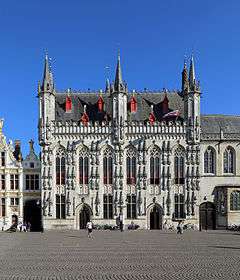Bruges City Hall
| Bruges City Hall Stadhuis van Brugge (Dutch) Hôtel de ville de Bruges (French) | |
|---|---|
 | |
| General information | |
| Architectural style | Gothic |
| Town or city | Bruges |
| Country | Belgium |
| Construction started | 1376 |
| Completed | 1421 (original completion) |
| Design and construction | |
| Architect |
- Unknown (probably Jan Roegiers; also possible: Jan van Rijssele or Mathieu Saghen) - Louis Delacenserie (restoration 1895-1905) - Jean-Baptiste Bethune (restoration 1895-1905) |
| Engineer | Jan Roegiers (1376-1421 construction phase) |
The Bruges City Hall is one of the oldest city halls in the entire Netherlands region.[1] It is located in Burg Square, the area of the former fortified castle in the centre of Bruges, Belgium.
After a fire in the city's Belfry in 1280 the old Ghyselhuus, which had already fallen into disuse as the jail of the count of Flanders, became the meeting place for the city council. In 1376 the Ghyselhuus was pulled down and replaced by a new purpose built council building. Count Louis laid the foundation stone.[2] Responsibility for its construction was given Jan Roegiers,[3] and the project was completed, eventually, in 1421.[3] The City Hall is the earliest late Gothic monumental-style municipal council building in Flanders or Brabant: its flamboyant opulence testifies to the city's economic and political power[3] at a time when the population of Bruges is believed to have reached more than 37,000, or even 45,000 people.[4]
The pioneering stone facade of the oldest part, which during the sixteenth and seventeenth centuries was several times extended towards the south, inspired in quick succession the city halls of Brussels, Ghent, Leuven and Oudenaarde.[3] The building's admirers highlight the effect of the "Brugian span", referring to the abundance of repeating systematically positioned niches encompassing the windows, though it is not clear that this effect was invented in Bruges.
The statues under the stone baldachin-canopies on the building's facade have been renewed several times. At the time of the French Revolution all the statues were destroyed. A small number of genuine pieces are now included in the collections of the city museum. The crenelated facade is topped off with little turrets and the roof is decorated with its own little crests and dormers. In 1766 the door on the left side of the building's facade was repositioned to make the overall effect more symmetrical.
Between 1895 and 1905 the distinguished local architect, Louis Delacenserie and the Gothic Revival champion Jean-Baptiste Bethune started the restoration of the interior.[5] The lesser and greater council chamber were replaced by a single "Gothic Hall". The rich decoration of this chamber now offered competition to the elaborate exterior facade. The impressive double vaulted timber ceiling was restored and extended to cover the entire area, while the vaulting over the two eastern bays dates only from the nineteenth century. Medallions in the bosses show New Testament scenes, prophets, evangelists and saints. Decoration of the corbels supporting the roof reflect natural and seasonal themes. On the walls mural paintings by Albrecht De Vriendt show scenes from the history of Bruges.[6] Like the monumental mantle-pieces these are nineteenth century neo-gothic enhancements. The stone vault from 1766 which had covered the lower level was at the same time replaced by a quasi-historical timber structure, supported by four columns that divide the room into two halves.
References
- ↑ "Stadhuis (City Hall)". Information office Markt (Historium), Brugge. Retrieved 4 August 2015.
- ↑ André Vandewalle, 'Het Brugs Stadhuis: 600 jaar geschiedenis', in: 600 jaar Brugs Stadhuis, 1376-1976, Bruges, 1976, p. 9
- 1 2 3 4 Livia Snauwaert (July 2002). Burg 12 Stadhuis. Gids voor architectuur in Brugge. Terra - Lannoo, Uitgeverij. ISBN 978-9020947113.
- ↑ James M. Murray, Bruges, Cradle of Capitalism, 1280-1390, Cambridge University Press, 2005, p. 84-86
- ↑ Arne Vandewalle; prof. dr. Linda Van Santvoort (supervisor) (2010). "Louis Delacenserie (1838-1909): meer dan neogothiek?" (PDF). doctoral dissertation. Universiteit Gent. Retrieved 5 August 2015.
- ↑ "Brugse stadhuis". Het lexicon Kunstbus (Guus Jurcka & Jacobine Feekes). Retrieved 5 August 2015.
Coordinates: 51°12′29″N 3°13′37″E / 51.2081°N 3.2269°E